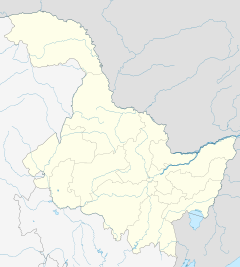鹤岗市
|
Hegang 鹤岗市 |
|
|---|---|
| Prefecture-level city | |

Hegang in 2013
|
|
 Hegang (red) in Heilongjiang (orange) |
|
| Location of the city centre in Heilongjiang | |
| Coordinates: 47°21′N 130°18′E / 47.350°N 130.300°ECoordinates: 47°21′N 130°18′E / 47.350°N 130.300°E | |
| Country | People's Republic of China |
| Province | Heilongjiang |
| County-level divisions | 8 |
| Settled | 1906 AD |
| Area | |
| • Prefecture-level city | 14,679.88 km2 (5,667.93 sq mi) |
| • Urban | 11,849 km2 (4,574.9 sq mi) |
| • Metro | 4,574.9 km2 (1,766.4 sq mi) |
| Elevation | 280 m (920 ft) |
| Population (2010 Census) | |
| • Prefecture-level city | 1,058,665 |
| • Density | 72/km2 (190/sq mi) |
| • Urban | 664,471 |
| • Urban density | 56/km2 (150/sq mi) |
| • Metro | 664,471 |
| • Metro density | 150/km2 (380/sq mi) |
| Time zone | China Standard (UTC+8) |
| Postal code | 154100 - 154200 |
| Area code(s) | +86/086 |
| License plate prefixes | 黑H |
| ISO 3166-2 | CN-23-04 |
| GDP (2007) | CNY 19.6 billion |
| - per capita | CNY 17818 |
| Climate | Dwb |
| Website | http://www.hegang.gov.cn |
| Hegang | |||||||

"Hegang", as written in Chinese
|
|||||||
| Chinese name | |||||||
|---|---|---|---|---|---|---|---|
| Simplified Chinese | 鹤岗 | ||||||
| Traditional Chinese | 鶴崗 | ||||||
|
|||||||
| Manchu name | |||||||
| Manchu script | ᡥᡝᡤᠠᠩ | ||||||
| Russian name | |||||||
| Russian | Хэган | ||||||
| Transcriptions | |
|---|---|
| Standard Mandarin | |
| Hanyu Pinyin | Hègǎng |
Hegang (Chinese: 鹤岗; pinyin: Hègǎng, also known as Haoli and Heligang), is a prefecture-level city in Heilongjiang province of the People's Republic of China, situated in the southeastern section of the Lesser Khingan Range, facing Jiamusi across the Songhua River to the south and Russia's Jewish Autonomous Oblast across the Amur River to the north. Hegang is one of the principal coal-producing cities in China. Hegang covers an administrative area of 14,679.88 km2 (5,667.93 sq mi) and according to the 2010 Census, has a population of 1,058,665 inhabitants. Its built-up area is home to 664,471 inhabitants spread out over 5 urban districts including Dongshan being urbanized, even though still largely rural.
The region of Hegang was a desolate and uninhabited area until the late 1890s. In 1906, the area of Hegang City was under the administration of Tangyuan County under the Qing Dynasty. Since then, the government has been encouraging people to farm in the region. In 1914, coalfield was discovered in Haoli, and Heilongjiang Government approved to set up Xinghua Mines (興華煤礦) which is jointly invested by merchants including Shen Songnian (沈松年). The area was also renamed Xingshan (興山) after the Xinghua Coal Mine. The Hegang mines were founded in 1916 by a Chinese entrepreneur with Russian capital. Hegang has witnessed rapid economic growth thanks to its rich coal resources. In 1926 a railway was built between Hegang and Jiamusi, some 30 miles to the south on the Songhua River. A coal carrier fleet was privately financed in 1930 by General Zhang Xueliang. On August 1932, Hegang mines were occupied by the Japanese as the Japanese Empire advanced through Manchuria. The mines were further developed during the Japanese occupation of Manchuria. On August 11, 1945, Hegang was occupied by the Soviet Red Army, and was relegated to the Communist Force. Since several major coal mines in southern Manchuria were controlled by Kuomintang Forces, Hegang became one of the main coal-producing area of Communist Force in the Chinese Civil-War, playing an important role in guaranteeing the acquisition of weapons and other war materials. Hegang was renamed in 1949, and set up as a prefecture-level city in Heilongjiang.
...
Wikipedia

